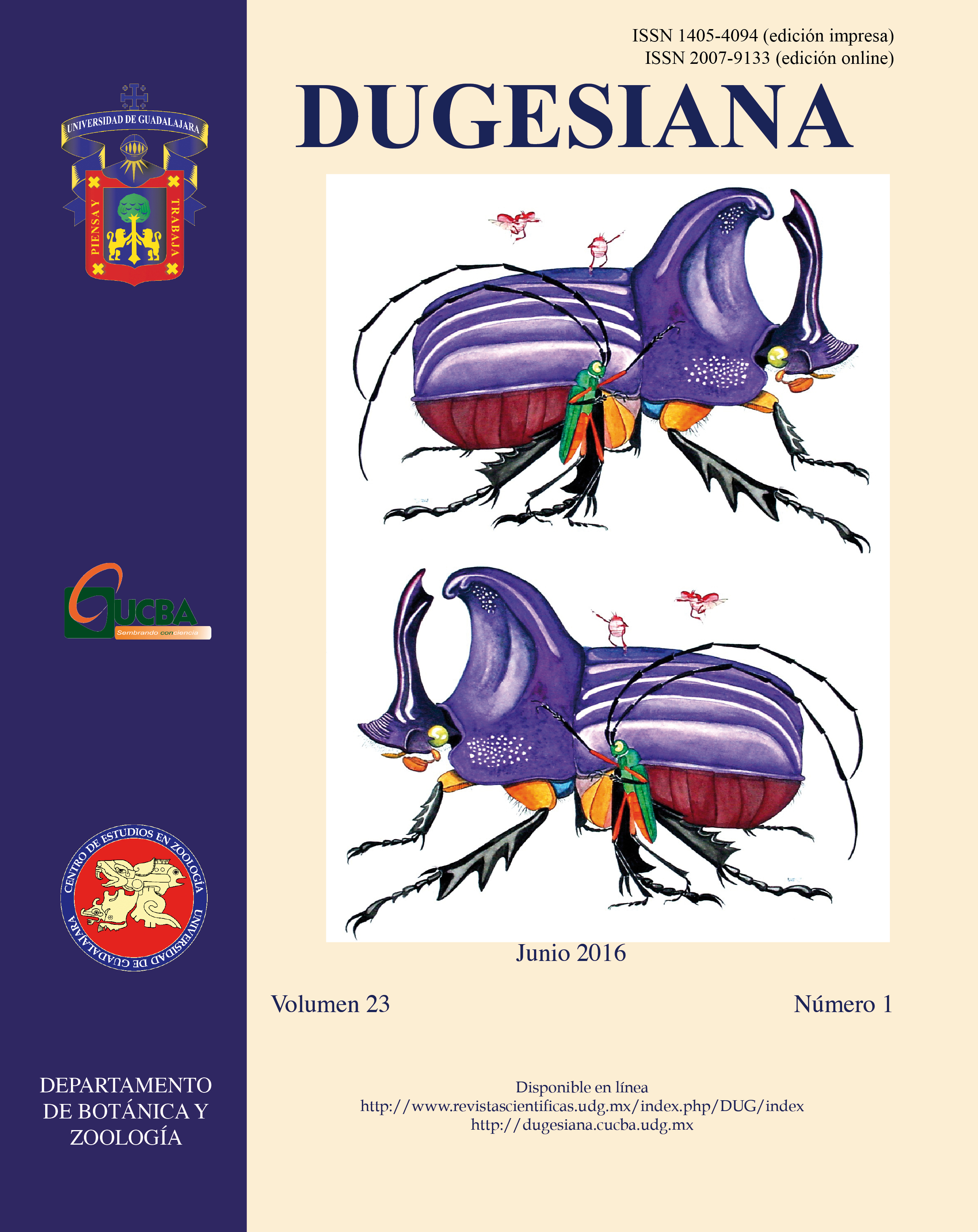Comunicación química de coleópteros Melolonthidae distribuidos en México: a una década de distancia
DOI:
https://doi.org/10.32870/dugesiana.v23i1.5748Abstract
Después de 10 años de estudios sobre ecología química de los coleópteros Melolonthidae (“melolóntidos”), se cuenta con registros de la “comunicación química sexual” (CQS) y de la “comunicación química alimentaria” (CQA) (interacción melolóntido-planta hospedera) de especies distribuidas en México de los géneros Phyllophaga, Macrodactylus, Cyclocephala y Paranomala. Esto ha permitido recopilar información sobre la comunicación química (“emisor”, “mensaje químico”, “receptor”) de algunas de estas especies. En lo referente a la CQS, en el “emisor” se han localizado tres posibles sitios de producción de atrayentes sexuales en las hembras de este grupo: 1) un epitelio secretor especializado ubicado en la cámara genital; 2) microorganismos endosimbióticos y 3) glándulas accesorias tipos I y II. El “mensaje químico” ha sido parcialmente identificado y probada su actividad biológica, encontrándose derivados fenólicos (butilhidroaxianisol), derivados de aminoácidos (3,3 dietil 2,4 azetidina-dione) y ácidos grasos (ácido hexadecanoico, ácido eurícico), entre otros compuestos. Para el “receptor”, se ha obtenido información sobre la anatomía y electrofisiología del sistema olfativo de estos escarabajos, además de identificar tipos y “subtipos” de quimiorreceptores antenales relacionados con la atracción sexual (sensilas placoideas y auricílicas). En el caso de la CQA, se han logrado probar algunos “emisores” (hojas y raíces de plantas consideradas hospederas de adultos de Macrodactylus), los cuales liberan “mensajes químicos” (aún por identificar) que provocan la atracción del “receptor” (hembras y machos, en este caso, con sensilas relacionadas con la captación de estos volátiles -basicónicas y celocónicas-). Por último, se discute el impacto de esta línea de investigación en el estudio de los melolóntidos mexicanos desde diferentes enfoques y las perspectivas de consolidación como alternativa para el conocimiento, manejo y conservación de la biodiversidad.Downloads
Published
2016-06-30
Issue
Section
Artículos
License
1. Proposed policy for open access journals
Those authors who have publications with this journal, accept the following terms:
- The authors will retain their copyright and will guarantee to the journal the right of first publication of their work, which will be simultaneously subject to the Creative Commons Recognition License, which allows third parties to share the work whenever their author is indicated and His first publication is this journal.
- Authors may adopt other non-exclusive license agreements to distribute the version of the published work (eg to be deposited in an institutional telematic file or published in a monographic volume) provided the initial publication is indicated in this journal .
Authors are encouraged and encouraged to disseminate their work through the Internet (eg in institutional telematic files or on their web page) before and during the sending process, which can produce interesting exchanges and increase appointments Of the published work. (See The effect of open access).
2. Proposed policy for journals that offer open deferred access
Those authors who have publications with this journal, accept the following terms:
- The authors will retain their copyrights and will guarantee to the journal the right of first publication of their work [SPECIFY PERIOD OF TIME], which will be simultaneously subject to the Creative Commons Recognition License that allows third parties to share the work always That its author and his first publication be indicated this journal.
- Authors may adopt other non-exclusive license agreements to distribute the version of the published work (eg to be deposited in an institutional telematic file or published in a monographic volume) provided the initial publication is indicated in this journal .
- Authors are encouraged and encouraged to disseminate their work through the Internet (eg in institutional telematic files or on their web page) before and during the sending process, which can produce interesting exchanges and increase appointments Of the published work. (See The effect of open access).




